Thejadeddog (talk | contribs) m (→The Fermentation Environment) |
Thejadeddog (talk | contribs) m (→The Fermentation Environment) |
||
| Line 10: | Line 10: | ||
Once the wort is aerated and the yeast has been added [[Pitching the Yeast|pitched]], the [[yeast]] should begin to reproduce, and eventually [[ferment]] the beer converting the fermentable sugars into alcohol and CO2. | Once the wort is aerated and the yeast has been added [[Pitching the Yeast|pitched]], the [[yeast]] should begin to reproduce, and eventually [[ferment]] the beer converting the fermentable sugars into alcohol and CO2. | ||
| − | Signs of fermentation include bubbles (burps) in the airlock and a layer of foam called [[ | + | Signs of fermentation include bubbles (burps) in the airlock and a layer of foam called [[krausen]] on top of the beer. The amount of time between pitching the yeast and the first signs of fermentation is referred to as "lag time". The goal of the attentive brewer is to keep the lag time within a reasonable limit. Lag times typically vary from as short as a few hours to as long as 48 hours. Using a yeast [[starter]] and [[Cooling, Racking, and Aerating|aeration]] methods, as well as keeping the fermentation temperatures within the accepted range, can help to reduce lag time. |
Most ale fermentations should be mostly complete within 10 days although fermentation times can vary anywhere from 4 days to 3 weeks. Lagers may take longer to finish fermenting, typically 2 to 3 weeks, and require at least a month of [[lagering]]. | Most ale fermentations should be mostly complete within 10 days although fermentation times can vary anywhere from 4 days to 3 weeks. Lagers may take longer to finish fermenting, typically 2 to 3 weeks, and require at least a month of [[lagering]]. | ||
Revision as of 18:13, 29 September 2007
Primary fermentation is when the wort finally becomes beer through the conversion of sugars into alcohol and carbon dioxide. This conversion is done by the yeast which "eat" the sugars; you just need to provide the right conditions for the yeast to do its job.
Contents
The Fermentation Environment
Once the wort is aerated and the yeast has been added pitched, the yeast should begin to reproduce, and eventually ferment the beer converting the fermentable sugars into alcohol and CO2.
Signs of fermentation include bubbles (burps) in the airlock and a layer of foam called krausen on top of the beer. The amount of time between pitching the yeast and the first signs of fermentation is referred to as "lag time". The goal of the attentive brewer is to keep the lag time within a reasonable limit. Lag times typically vary from as short as a few hours to as long as 48 hours. Using a yeast starter and aeration methods, as well as keeping the fermentation temperatures within the accepted range, can help to reduce lag time.
Most ale fermentations should be mostly complete within 10 days although fermentation times can vary anywhere from 4 days to 3 weeks. Lagers may take longer to finish fermenting, typically 2 to 3 weeks, and require at least a month of lagering.
A critical component to the fermentation environment is the temperature of the wort at pitching and during fermentation.
Fermentation Temperature
The appropriate fermentation temperature varies from one yeast strain to the next. In general, ales ferment anywhere between 60 and 70 degrees F while lagers ferment between 50 and 60 degrees F. Fermenting at too low a temperature can result in a slow or "stuck" fermentation in which the yeast become dormant before all the sugars have been converted. Fermenting at too high a temperature can lead to off-flavors due to the production of esthers. There are different steps brewers can take to control the temperature throughout the fermentation process.
Choosing the Right Fermentation Vessel
|
This section is a stub.
|
Airlocks and Blow-Offs
|
This section is a stub.
|
Advanced Fermentation Temperature Control
|
This section is a stub.
|
When is Primary Fermentation Complete?
|
This section is a stub.
|
What do I do next?
Once primary fermentation is complete, you may want to take extra measures by way of Conditioning the Beer, such as a secondary fermentation or lagering. Or, beginning brewers can skip straight to the final step in the beer brewing process: Packaging and Carbonation.

